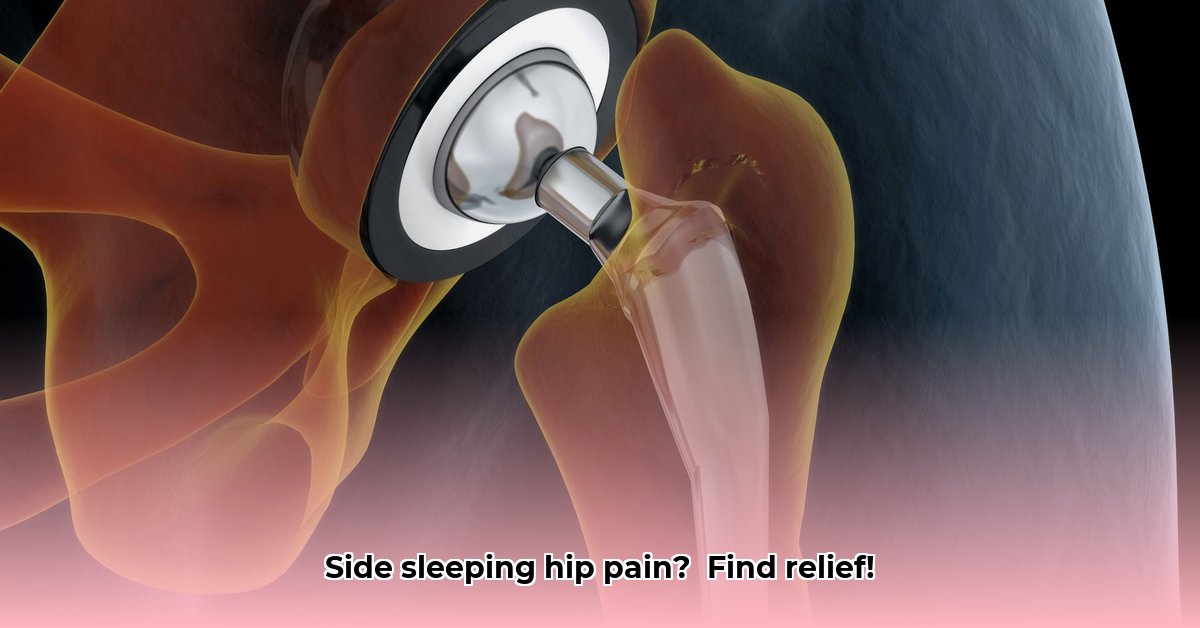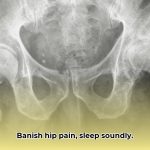That stabbing hip pain that keeps you up at night? You’re not the only one. Many people find their hip pain is much worse when they sleep on their side. This guide will help you figure out what’s causing the problem – it could be something simple like a muscle strain, or something more serious like hip bursitis or gluteal tendinopathy. We’ll walk you through how to find comfortable positions, and give you easy-to-follow tips to help you get a good night’s sleep again. We’ll even share some strategies to prevent the pain from coming back. For more in-depth information, check out this helpful guide: Hip Pain Solutions. Let’s get you sleeping soundly!
Hip Pain Sleeping on Your Side: Sweet Dreams, No More Aches!
Waking up with a hip that screams? You’re not alone! Many people find themselves battling hip pain when they sleep on their side. It’s incredibly frustrating, but the good news is there are things you can do to find relief, manage hip discomfort, and get back to enjoying those peaceful nights. Let’s dive into why this happens and what you can do to fix it.
Uncovering the Mystery of Your Hip Pain
That nagging hip pain while you’re trying to sleep could stem from a number of things, from a simple muscle strain that’ll clear up quickly to something a bit more long-term, like arthritis or piriformis syndrome. The way you sleep plays a huge role. If you always sleep on the same side, you’re essentially putting that hip under constant pressure, leading to stiffness and pain. An old, lumpy mattress doesn’t help either; it just won’t give you the support your body needs. If you’re pregnant, hormonal changes and your growing belly can really put extra stress on your hips, leading to some seriously uncomfortable nights. Conditions like osteoarthritis, rheumatoid arthritis, bursitis (inflammation of the fluid-filled sacs around your joints), hip tendonitis, or even a simple muscle pull can all be made significantly worse by sleeping on your side. Snapping hip syndrome may also contribute to the pain, causing a popping sensation with movement. Do conditions like hip impingement also contribute to the pain?
Getting to the Root of the Problem
To effectively tackle your hip pain, you need to figure out what’s causing it and find effective treatment options. That’s where a doctor or physical therapist comes in. They’ll want to chat with you about your symptoms, your health history, and how you generally live your life. They’ll likely do a physical exam to see how well you can move your hip and check for any obvious problems. They might even order some imaging tests, like X-rays or an MRI, to get a really good look at your hip joint and the surrounding tissues. The goal is to get a precise diagnosis – is it osteoarthritis, bursitis, a pulled muscle, piriformis syndrome, or something else entirely? The right diagnosis is the key to the right treatment. Lab tests might also be necessary to rule out autoimmune disorders like rheumatoid arthritis.
Your Action Plan for Hip Pain Relief: A Step-by-Step Guide
Managing hip pain while side sleeping often involves a few different strategies working together:
1. Sleep Sanctuary Makeover:
- Mattress Upgrade: Your mattress is your foundation for a good night’s sleep. If it’s old, saggy, or doesn’t support your body properly, it’s time for an upgrade. A medium-firm mattress, perhaps one made of memory foam or latex, is often recommended for hip pain sufferers. These mattresses conform to your body’s shape but still offer enough support to keep your spine aligned. Consider a sleep number mattress, allowing each person to adjust firmness.
- Pillow Power: Pillows are your secret weapons. Place a pillow between your knees to keep your hips aligned and reduce pressure on your hip joint. This helps prevent your top leg from rolling onto your hip. You can also place a pillow under your upper body to support your posture and take pressure off your hips. A body pillow can provide even more support.
- Positional Adjustments: Sleeping on your side is the main culprit, so consider experimenting with other positions. Sleeping on your back may help redistribute the weight, or you might prefer sleeping on your less painful side. Small adjustments can make a big difference in alleviating pressure points.
2. Home Remedies: Simple Solutions, Big Impact:
- Ice, Ice, Baby: Applying an ice pack for 15-20 minutes a few times a day can help reduce inflammation and ease pain, especially in cases of bursitis or tendonitis. Remember to wrap the ice pack in a thin towel to protect your skin.
- Heat Therapy: Gentle heat can help relax tense muscles, particularly if muscle tightness is contributing to your pain. Try a heating pad, a warm bath, or even a warm shower.
- Over-the-Counter Pain Relief: Non-steroidal anti-inflammatory drugs (NSAIDs), like ibuprofen or naproxen, can lessen pain and inflammation. Acetaminophen (Tylenol) can also help manage pain. Always read and follow the instructions on the packaging. Be aware that some drugs can contribute to sleep problems, so discuss options with your doctor. What other medication options could provide relief?
- Anti-inflammatory Diet: Incorporate foods with turmeric, lemon water, antioxidants, and omega-3 fatty acids into your diet to help reduce inflammation.
3. Gentle Movement: Exercises That Heal:
Gentle stretches and strengthening exercises can really improve your hip’s mobility and stability, making your pain more manageable. It’s best to work with a physical therapist who can create a program tailored to your specific needs and guide you on proper form. Some examples include gentle hip flexor stretches to loosen tight muscles, glute strengthening exercises to support your hip joint, and core strengthening to improve overall body stability. Eccentric exercises, like glute bridges with a slow descent, can be particularly helpful for gluteal tendinopathy. Remember – start slowly and gradually increase the intensity as you feel comfortable. Yoga or pilates can also improve flexibility and strength.
4. When to Seek Professional Help:
If your pain doesn’t improve with home remedies, persists, or is severe, don’t hesitate to see a doctor or physical therapist. They can guide you through a tailored exercise plan, teach you pain management techniques, and explore other therapeutic options like manual therapy (hands-on treatment to adjust joints and muscles) or acupuncture. In more serious cases, your doctor might suggest steroid injections or, in rare instances, surgery. Physical therapy is commonly used to treat hip bursitis and tendon injuries.
Long-Term Hip Health: A Plan for Prevention
Maintaining a healthy weight, regular exercise (especially low-impact activities like swimming or walking), and paying attention to your posture can all make a huge difference in your long-term hip health. These habits can significantly reduce the stress on your hips and joints. Avoiding overuse injuries and managing underlying conditions like diabetes or high cholesterol can also help. Keeping up with regular check-ups with your doctor, especially if you have a chronic condition, ensures you catch any potential issues early. About what percentage of people who maintain a lower weight experience statistically less hip discomfort?
Let’s be honest: Hip pain is a real nuisance. But with the right approach, combining smart sleeping habits, home care, gentle exercise, and professional guidance, you can find lasting relief and get back to sleeping soundly. You deserve those sweet, pain-free dreams!
How to Treat Severe Hip Pain at Night Preventing Sleep
Key Takeaways:
- Side sleeping often intensifies hip pain due to increased pressure.
- Several factors, like bursitis or arthritis, contribute to nighttime hip discomfort.
- A multi-pronged approach addressing sleep position, pain relief, and lifestyle helps effectively.
- Lifestyle changes (weight management), medication, and physical therapy can improve hip mobility.
Understanding Your Hip Pain
Nighttime hip pain can be intensely frustrating, robbing you of restful sleep. It’s often worse when sleeping on your side, placing extra pressure on your hip joint. But what causes this? Many factors contribute. Think osteoarthritis, wearing down cartilage; bursitis, inflammation of fluid-filled sacs; gluteal tendinopathy, affecting tendons connecting glutes and hip bone; or even muscle imbalances. Piriformis syndrome, where the sciatic nerve is compressed, can also cause hip and buttock pain. Pregnancy can also cause temporary hip pain due to weight gain and hormonal changes. Identifying the root cause is key to effective treatment.
Finding Relief: Strategies for Sleep
How to treat severe hip pain at night preventing sleep involves addressing several areas:
1. Adjusting Your Sleep Position
- Side Sleeping Modifications: If you must sleep on your side, place a pillow between your knees and another supporting your lower back to maintain spinal alignment. Support your hips by adding a rolled-up towel or pillow.
- Back Sleeping: Consider switching to your back. A supportive pillow under your knees and a rolled towel under your lower back can alleviate pressure points. This may improve spinal alignment and decrease hip stress.
- Mattress Topper: Add a mattress topper if you suspect mattress is the problem.
2. Over-the-Counter Pain Relief
Nonsteroidal anti-inflammatory drugs (NSAIDs), like ibuprofen, can reduce inflammation and pain. Acetaminophen (Tylenol) can also help manage discomfort. Always follow package directions.
3. Home Remedies and Lifestyle Changes
- Heat or Ice: Apply heat or ice packs
- Unlock Young Doctors’ Work-Life Balance: Actionable Strategies Now - December 2, 2025
- Unlock Life Harmony: Work-Life Integration Guide - November 30, 2025
- Unlock Work-Life Harmony:Your Guide to Integration - November 27, 2025
















